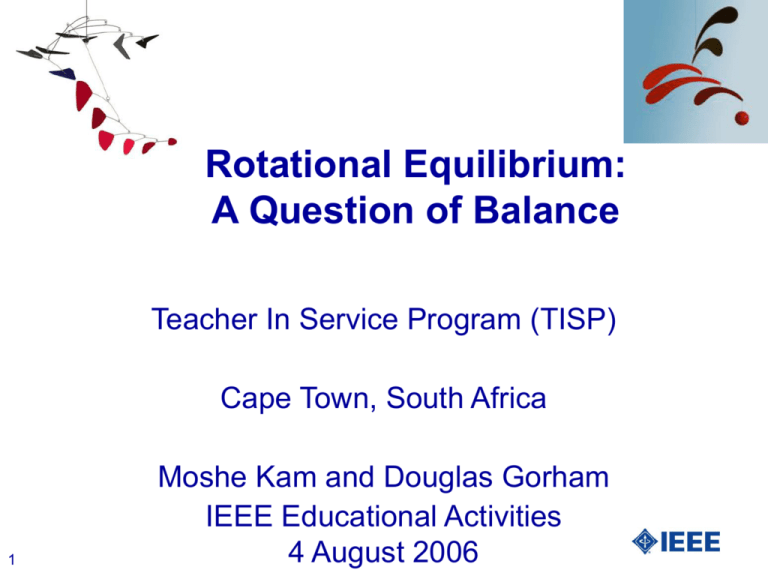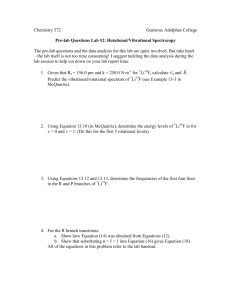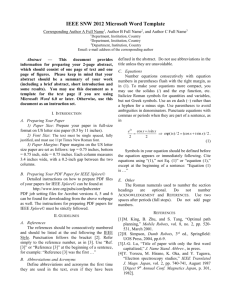Rotational Equilibrium Presentation
advertisement

Rotational Equilibrium: A Question of Balance Teacher In Service Program (TISP) Cape Town, South Africa 1 Moshe Kam and Douglas Gorham IEEE Educational Activities 4 August 2006 Who are we? This weekend’s workshop is a joint activity of two organizational units of IEEE The IEEE Educational Activities Board (EAB) The IEEE South Africa Section (est. 1977) IEEE is a transnational organization dedicated to engineering, technology and science Established in 1963 by two associations 2 AIEE (est. 1884) and IRE (est. 1912) Attributes of IEEE Largest engineering association in the world 360,000 members in 150 countries Major publisher and organizer of conferences Major developers of standards Provider of communication and networking opportunities for engineers, scientists, and technology practitioners A public charity, dedicated to serving the public 3 Guided and lead by VOLUNTEERS What do you need to know about TISP? (1) It is a program of IEEE It is about using IEEE volunteers to help preuniversity teachers 4 Specifically, IEEE’s Educational Activities Board (EAB) Teachers of technology, mathematics, and science What do you need to know about TISP? (2) The basic idea: present teachers with lesson plans that they can use to enhance student understanding of Engineering and Engineering Design 5 The ultimate outcome is classroom activities with students about Engineering We are concentrating, however, on interacting with the teachers Success = teachers take our lesson plans to their classrooms All TISP lesson plans need to be aligned with national curriculum standards What are we going to do today? 6 Simulate a TISP activity Provide an opportunity for volunteers to experience first hand what we are trying to do with teachers Motivate IEEE volunteers to conduct TISP sessions with educators throughout the pre-university educational system in South Africa Lesson content We will build a Mobile to meet specifications Including basic calculations of design parameters 7 In teams of 2 We will develop specifications for a second Mobile and then build it How does this lesson align with Educational Standards in South Africa ? 8 Alignment to National Curriculum Statements Critical Outcomes As a result of the activities, all learners should develop and demonstrate the ability to; 9 identify and solve problems and make decisions using critical and creative thinking; work effectively with others as members of a team, group, organisation and community; organise and manage themselves and their activities responsibly and effectively; collect, analyse, organise and critically evaluate information; communicate effectively using visual, symbolic and/or language skills in various modes; use science and technology effectively and critically showing responsibility towards the environment and the health of others; and demonstrate an understanding of the world as a set of related systems by recognising that problem solving contexts do not exist in isolation. Learning Outcomes of Mathematics: Grade 10 As a result of the activities, all learners should develop and demonstrate the ability to; Generate as many graphs as necessary, initially by means of pointby-point plotting, supported by available technology, to make test conjectures and hence to generalise the effects of the parameters a and g on the graphs of the functions.(10.2.2) Investigate, generalise and apply the effect of the following transformations of the point (x; y): 10 A translation of p units horizontally and q units vertically; A reflection in the x-axis, the y-axis or the line y = x. (10.3.4) Demonstrate an appreciation of the contribution to the history of the development and use of geometry and trigonometry by various cultures through a project. (10.3.7) Learning Outcomes of Physical Science: Grade 10 As a result of the activities, all learners should develop and demonstrate the ability to; 11 plan and conduct a scientific investigation to collect data systematically with regard to accuracy, reliability and the need to control one variable. (10.1.1) seek patterns and trends in information collection and link it to existing scientific knowledge to help draw conclusions. (10.1.2) Communicate information and conclusions with clarity and precision (10.1.4) Apply scientific knowledge in familiar, simple contexts. (10.2.2) Learning Outcomes of Mechanical Technology: Grade 10 As a result of the activities, all learners should develop and demonstrate the ability to; 12 present assignments by means of a variety of communication media. (10.2.5) describe the functions of appropriate basic tools and equipment (10.3.2) explain the use of semi-permanent joining applications (10.3.5) distinguish between different types of forces found in engineering components by graphically determining the nature of these forces (10.3.6) Learning Outcomes of Civil Technology Grade 10 As a result of the activities, all learners should develop and demonstrate the ability to; 13 present assignments by means of a variety of communication media. (10.2.5) describe the properties and the use of materials in the built environment. (10.3.2) describe functions, use and care of basic tools and equipment. (10.3.3) demonstrate an understanding of applicable terminology. (10.3.5) distinguish between different types of forces found in load bearing structures. (10.3.6) list different manufacturing process or construction methods. (10.3.7) identify quantities of materials for small projects. (10.3.9) explain the use of different joining applications. (methods) (10.3.10) Today’s activity: Build a Mobile 14 Focus and Objectives Focus: demonstrate the concept of rotational equilibrium Objectives Learn about rotational equilibrium Solve simple systems of algebraic equations 15 Apply graphing techniques to solve systems of algebraic equations Learn to make predictions and draw conclusions Learn about teamwork and working in groups Anticipated Learner Outcomes As a result of this activity, students should develop an understanding of 16 Rotational equilibrium Systems of algebraic equations Solution techniques of algebraic equations Making and testing predictions Teamwork Concepts the teacher needs to introduce 17 Mass and Force Linear and angular acceleration Center of Mass Center of Gravity Torque Equilibrium Momentum and angular momentum Vectors Free body diagrams Algebraic equations Theory required Newton’s first and second laws Conditions for equilibrium Translational Rotational Conditions for rotational equilibrium Linear and angular accelerations are zero Torque due to the weight of an object Techniques for solving algebraic equations 18 S F = 0 (Force Balance) S t = 0 (Torque Balance) Substitution, graphic techniques, Cramer’s Rule Mobile A Mobile is a type of kinetic sculpture Constructed to take advantage of the principle of equilibrium Consists of a number of rods, from which weighted objects or further rods hang The objects hanging from the rods balance each other, so that the rods remain more or less horizontal Each rod hangs from only one string, which gives it freedom to rotate about the string 19 http://en.wikipedia.org/wiki/Mobile_(sculpture) 3 August 2006 Historical Origins Name was coined by Marcel Duchamp in 1931 to describe works by Alexander Calder Duchamp Alexander Calder 20 French-American artist, 1887-1968 Associated with Surrealism and Dada American artist, 1898-1976 “Inventor of the Mobile” 21 22 Standing Mobile, 1937 Lobster Tail and Fish Trap, 1939, mobile Mobile, 1941 Hanging Apricot, 23 1951, standing mobile Alexander Calder on building a mobile "I used to begin with fairly complete drawings, but now I start by cutting out a lot of shapes.... Some I keep because they're pleasing or dynamic. Some are bits I just happen to find. Then I arrange them, like papier collé, on a table, and "paint" them -- that is, arrange them, with wires between the pieces if it's to be a mobile, for the overall pattern. Finally I cut some more of them with my shears, calculating for balance this time." Calder's Universe, 1976. 24 Our Mobiles Version 1 Version 2 25 A three-level Mobile with four weights Tight specifications An individual design under general constraints Version 1 A three-level four-weight design Level 1 Level 2 Level 3 26 Materials 27 Rods made of balsa wood sticks, 30cm long Strings made of sewing thread or fishing string 5-cent coins 240 weight paper (“cardboard”) Adhesive tape Paper and pens/pencils Tools and Accessories Scissors 30cm Ruler Hole Punchers Band Saw (optional) Pens Marking pen Wine/water glasses Calculator (optional) Binder clips 28 Instructions and basic constraints Weights are made of two 5 cent coins taped to a circular piece of cardboard One coin on each side Each weight is tied to a string 29 If you wish to do it with only one coin it will be slightly harder to do The string is connected to a rod 5mm from the edge 5 mm 30 Rods of level 3 and 2 are tied to rods of level 2 and 1 respective at a distance of 5mm from the edge of the lower level rod 5 mm Level 1 Level 2 Level 3 31 Designing the Mobile Write and solve the equations for xi And yi (i=1,2,3) Level 3 32 W x1 = W y1 x1 + y1 = 290 290 mm Level 2 2W x2 = W y2 x2 + y2 = 290 Level 1 3W x3 = W y3 x3 + y3 = 290 33 Solve Equations for Level 1 By substitution 34 3 W x3 = W y3 (1) x3 + y3 = 290 (2) From (1): y3 = 3x3 (3) Substitute (3) in (2): 4x3 = 290 or x3 = 72.5mm (4) From (2) y3 = 290 – x3 or y3 = 217.5mm (5) Solve Equations for Level 1 Using Cramer’s Rule 3 W x3 = W y3 (1) x3 + y3 = 290 (2) From (1): y3 = 3x3 or 3x3-y3=0 (3) From (1) and (2) using Cramer’s rule 0 x3 35 1 290 1 290 72.5 3 1 4 1 1 3 0 1 290 870 y3 217.5 3 1 4 1 1 Solve Equations for Level 1 Using Graphics Generate points for: Y3 = 3X3 Y3 = 290 - X3 36 Numerical values for graph 37 x3 y3 0 50 100 150 200 0 150 300 450 600 y3 290 240 190 140 90 Graphic Solution 800 y 600 y=3x 400 y=290-x 200 0 0 50 100 x x and y in mm The intersection is at x=72.5mm y=217.5mm 38 150 200 Graphic solution from handout 39 Activity 1: Build Version-1 Mobile 40 Record actual results Compare expected values to actual values Explain deviations from expected values Hints Use at least 30cm strings to hang weights Use at least 40cm strings to connect levels 41 Sewing strings much easier to work with than fishing string If you are very close to balance, use adhesive tape to add small amount of weight to one of the sides Version 2 Design a more complicated mobile First, provide a detailed design and diagram with all quantities 42 More levels (say 5) Three weights on lowest rod, at least two on each one of the other rods Different weights Show all calculations, specify all weights, lengths, etc. Then, build, analyze and provide a short report Report Description of the design, its objectives and main attributes A free body diagram of the design A description of the final product 43 All forces and lengths should be marked Key calculations should be shown and explained Where and in what areas did it deviate from the design Any additional insights, comments, and suggestions Questions for Participants What was the best attribute of your design? What is one thing you would change about your design based on your experience? What approximations did we make in calculating positions for strings? How did they affect our results? How would the matching of design to reality change if we… 44 Used heavier weights Used heavier strings Used strings of different lengths connected to the weights Used heavier rods To educators: Can you implement this lesson plan in your classroom? Questions, comments, reflections 45




